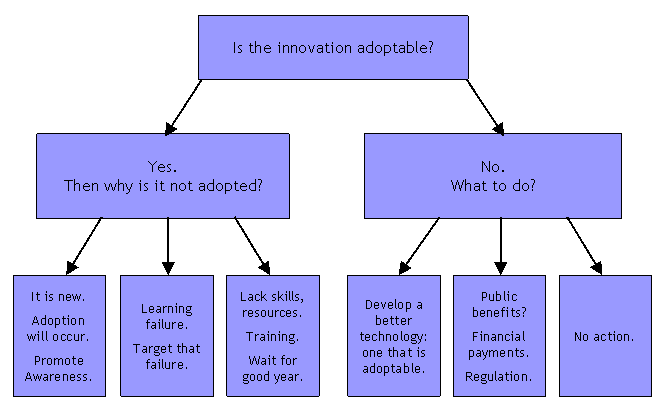141 – Thinking strategically about practice change
Extension is one of the tools that can be used to promote practice change by rural landholders, but it is not the only one. When is it appropriate to rely on extension as the main tool to encourage practice change, and what broad type of extension would be used in different circumstances.
Our national symposium on “Understanding Practice Change by Farmers” on November 14 was a successful day, with plenty of positive feedback from the 400 delegates. PowerPoint slides from the day are now available here, and within a month or so, you will be able to podcast complete audio recordings of all of the talks, and view video of edited versions of each talk at the new ruralpracticechange.org web site. In the meantime, here is a snippet from my talk on policy aspects of practice change.
My Public: Private Benefits Framework (PPBF) highlights the importance of the “adoptability” of a proposed new practice as a driver of the appropriate policy response. The “private net benefits” of a change in practice basically means the adoptability of the practice: how attractive or unattractive is it to landholders? This obviously is a complex issue depending on many factors, not just financial outcomes (Pannell et al. 2006).
The figure below presents some conclusions from the PPBF in a different way, and elaborates on some of them. It shows how the decision to use extension as the main tool to promote practice change depends on whether the practice is adoptable, and breaks down the type of extension that is relevant depending on other factors.
Figure 1. Choice of strategy to promote practice change depends on the adoptability of the practices being promoted, and other considerations.
Note that, if the practice is judged to be adoptable, there are three different modes of extension suggested, depending on why it isn’t already adopted.
(a) If the practice is not yet adopted, but is on track to adopted over time, there may be benefits from using extension to raise awareness of the practice in order to accelerate adoption. This is relevant to new practices, not ones that are well known to managers already.
(b) If the practice is well known, and you judge that it is adoptable, but it is not yet adopted, it implies that there is some sort of learning failure. In other words, the land managers may have a misperception about some important aspect of the practice. Rick Llewellyn has devised an approach for identifying such misperceptions, and determining which of them matter (Llewellyn et al. 2005). Extension would be targeted at fixing those misperceptions that can make a difference to adoption.
(c) If the thing holding back adoption is lack of skills, extension would focus on training.
If the problem is lack of resources, there may be little to do except wait, in the hope that a good season will provide those resources. Alternatively, if there are large public benefits from the practice, it may be appropriate to provide modest financial support, to provide the required resources to get the landholder over the adoption hump.
If the practice is judged to be lacking in adoptability among the target group, the options would include the following.
(d) Develop a better technology that is attractive enough to be adoptable.
(e) If there are large enough public benefits, it may be worth using financial payments or regulation (depending on whether it is judged that polluters should pay or beneficiaries should pay) to support or require adoption.
(f) If the costs of adoption are too high relative to the public benefits, and technology development is not attractive, the best option is probably no action. Effort should be directed elsewhere.
In cases (d) and (e) extension is not recommended as the main front-line policy tool, although it may be used in support of technology development, incentive payments or regulation.
David Pannell, The University of Western Australia
Further Reading
Llewellyn, R.S., Lindner, R.K., Pannell D.J. & Powles, S.B. (2005). Targeting key perceptions when planning and evaluating extension, Australian Journal of Experimental Agriculture 45: 1627-1633. Full paper (52K)
Pannell, D.J., Marshall, G.R., Barr, N., Curtis, A., Vanclay, F. and Wilkinson, R. (2006). Understanding and promoting adoption of conservation practices by rural landholders. Australian Journal of Experimental Agriculture 46(11): 1407-1424.
If you or your organisation subscribes to the Australian Journal of Experimental Agriculture you can access the paper at: http://www.publish.csiro.au/nid/72/paper/EA05037.htm (or non-subscribers can buy a copy on-line for A$25). Otherwise, email David.Pannell@uwa.edu.au to ask for a copy.
